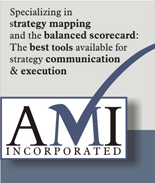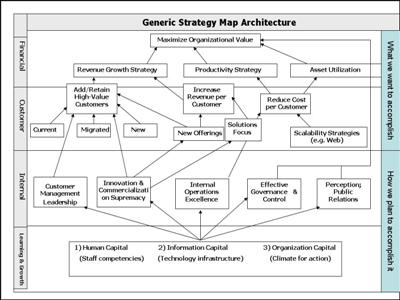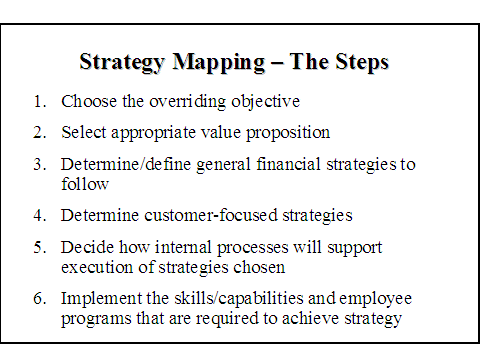
 |
 |

Introduced in 2000 by Kaplan and Norton, strategy mapping quickly became a popular approach for organizations to use in the strategy formulation process. It was recognized immediately as a simple yet powerful tool for depicting and formulating strategy. By using cause-and-effect diagrams, a strategy can be depicted in such a way that it is clear not just to those formulating the strategy, but to the majority of employees charged with executing the strategy. Many strategies fail in the execution stage as a result of communication issues - strategy mapping alleviates many of these communication issues through the use of pictures, something most everyone can understand.
The strategy map is created using a framework that plots the dimensions of the balanced scorecard down the left side. Across the top are the generic financial strategies of the organization, namely: increase revenue, decrease cost per customer, and improve asset utilization. The main idea of the mapping process is to plot the organization's financial objectives in the financial area (also referred to as the 'outcome' area), then use the map as a cause-and-effect architecture to show how the strategy in each dimension is to be carried out to achieve the desired outcomes.
Figure 1 below provides a diagram of what the strategy map of a profit-seeking organization might look like (several variations of maps exist). The mapping process starts with one overarching objective: to improve shareholder value. Two generic strategies are often employed to achieve this: a revenue strategy and a productivity strategy. The key to success is to find the optimal mix in emphasis and approach between these two strategies. Companies that attempt to attend to both equally generally flounder since there is nothing unique about the company - nothing it is better at than the competition.
Figure 1 - Generic Strategy Map
CLICK TO ENLARGE

Looking to the left side of the diagram, the revenue strategy can be executed by a combination of two approaches. First, the company can increase the number of high-value customers (a high value customer loosely defined is one that assists the organization to increase organizational wealth). By keeping the current set of high-value customers, trying to convince others to move over, and capturing new entrants, the company can increase the number of high-value customers. Second, the company can look to increasing the revenue per customer, through concepts such as cross-selling and providing new goods and services to complement the current offerings. Similarly, an emphasis on improving shareholder value through productivity improvements would lead to two key approaches - streamlining costs through efficiencies and the judicious management of assets such as inventories and receivables and fixed assets.
Once these strategies have been determined, the internal and learning and growth dimensions are completed to reflect the requirements for execution of these strategies. An organization should also ensure that it has sound employee initiatives, since the health and morale of the employee base is an important factor in achieving any strategy.
While no one correct method of creation had been established for strategy mapping, the workshop leader had come up with a useful, six-step process for strategy mapping. It is found below:

Value Propositions
The choice of competing primarily through a revenue or productivity strategy is heavily dependent on how the firm plans to differentiate itself from its competitors. The concept of value propositions offered by Treacy and Weirsema can assist in terms of choice of strategy. The general idea behind this approach is that, to dominate a market, a company should narrow its focus to a specific segment of the market and create a breakthrough where customers will place value higher than that of the competitors. The choice is represented by one of three value propositions: operational excellence, product leadership, and customer intimacy. The choice of a value proposition does not mean that a company ignores or neglects elements that are not the primary focus of that proposition. Instead, it means that the company's goals for elements not emphasized by the value proposition should be set just high enough to keep up with the competition, thus freeing resources and energies to hone at least one component of value to stand out against competitors.
Other hotels had been successful with this approach. For example, the Formule 1 hotel chain in Europe has chosen the value proposition of operational excellence and is able to provide accommodations at the lowest prices ($US 20 - 30 per night). By providing bare minimum features and a good night sleep, Formule 1 has been able to obtain a huge market share. Another example is the Ritz-Carlton, which works very hard to maintain a long-term relationship with its customers and is able to charge a premium for that relationship. It had invested in information technology that tracks customers specific preferences, such as soft drinks or hypo-allergenic pillows, at all Ritz-Carlton hotels worldwide. When customers arrive, their room is waiting with all their preferences looked after.
The information in this section was referenced from: R. Kaplan and D. Norton, "The Strategy-Focused Organization: How Balanced Scorecard Companies Thrive in the New Business Environment", ( Boston : Harvard Business School Press, 2001)
The information in this section was referenced from: M. Treacy and F. Weirsema, "The Discipline of Market Leaders: Choose Your Customers, Narrow Your Focus, Dominate Your Market", (Cambridge: Perseus Books, 1995)
CLICK HERE IF YOU WOULD LIKE TO VIEW OUR WORKSHOP INFORMATION
HOME | SERVICES | TESTIMONIALS | PUBLICATIONS | STRATEGY MAPPING | THE BALANCED SCORECARD | RISK MANAGEMENT | ABOUT US | CONTACT US
Property of AMI Incorporation, 2006 |
Designed by ellips design + consulting